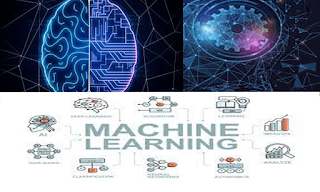Understanding the Foundations of Machine Learning (ML) and its Function in AI
Artificial
intelligence (AI), which focuses on building systems that can learn from the
data they examine and improve their performance, includes machine learning, or
ML for short. ML is a crucial area of AI, even though the term "AI"
refers to a wider range of systems that attempt to imitate some aspect of human
intellect. Although the two phrases are frequently used synonymously, they have
different meanings.
ML is now
essential to many facets of our daily life. ML algorithms are used to boost
security, streamline operations, and improve user experiences when we bank,
shop online, or use social media. We're still learning about the possibilities
of ML, which is always developing.
Supervised and Unsupervised Machine Learning: The Two Main Methods
In machine
learning, there are primarily two methods of learning: supervised and
unsupervised.
On the other
hand, unsupervised learning is more independent and allows the computer to
learn to recognize intricate patterns and processes without constant human
supervision. This is comparable to a youngster learning to recognize fruits by
looking at their colors and patterns instead of learning their names. The young
youngster labels each bunch of fruits after grouping similar fruits together.
K-means clustering, independent principal component analysis, and association
rules are a few examples of unsupervised ML methods.
How to select
the appropriate machine learning strategy for your project
The volume
and structure of the data, as well as the specific goal of the application, all
influence the decision between supervised and unsupervised learning. Customer
lifecycle management, anomaly detection, dynamic pricing, predictive
maintenance, picture classification, and recommendation engines are just a few
of the industries where machine learning has found a place.
Computer
learning and programmers
Developers
who dive into the interesting field of machine learning gain great advantages
from their knowledge of statistics, probability, and analysis. These abilities
are crucial for developing models that can learn and get better over time.
Developers are well-suited to understand the technologies used by many other
professionals to train current machine learning algorithms due to their
experience in these domains.
Which of
their algorithms will be supervised or unsupervised is one of the key decisions
that developers must make. How the model is taught and developed will depend on
this strategic choice. At the beginning of a project, developers have the
option of designing and configuring a model and then letting it learn with little
assistance from them. This method allows for a considerable deal of flexibility
in tailoring the model to the particular requirements of the project.
It's
interesting how with machine learning, the distinction between a developer and
a data scientist is frequently blurred. Sometimes, data scientists assist in
the development of final user-facing solutions while developers are in charge
of synthesizing data from a machine learning model. The success of machine
learning programs depends on this vibrant interaction between these two fields
of study. It combines the data scientists' deep understanding of the data with
the developers' technical know-how to produce more effective and practical
machine-learning solutions for users.
In the end,
machine learning gives programmers a fascinating chance to discover new worlds
and contribute to the development of sophisticated systems that enhance our
planet. The machine learning revolution is made possible by developers'
abilities and ingenuity, and their cooperation with data scientists lays the
path for even more remarkable developments in this sector that are always
changing.
In summary,
machine learning is a fundamental component of artificial intelligence that
enables computers to develop by learning from data. Solutions for a range of
applications in many industries are available using two major techniques,
supervised and unsupervised. As machine learning (ML) advances, it has grown to
be a potent tool for tackling challenging issues and revolutionizing many
facets of our daily lives.
See also:



